|
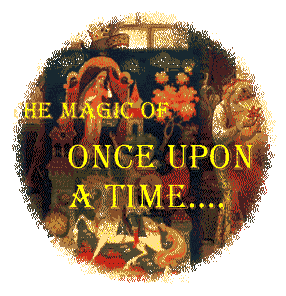
Narrative Logo - Click for Main Menu
Lecture VI: The Ancient Skies and the Origins of the World
What Origin
Tales Tell Us about Culture

Caption: The Orange Sun
The Sun in Story

Caption: Another view of the Sun
Amaterasu
was the Sun
goddess of the oldest Japanese religion called
Shinto. When her brother Susanowo treated her badly, she hid in the cave of heaven and
closed the entrance with an enormous stone. This made the world dark, and evil spirits
came out of their hiding places.
In despair, a conference of the gods decided to trick Amaterasu into
coming out by having a party near the cave. They put a big mirror in front
of the cave and beautiful jewels on a tree. Uzume, the goddess of laughter,
began a dance accompanied by loud music.
Hearing the music and laughter, Amaterasu was so curious that she took a
look outside to find out what was going on. She was so fascinated by her own brilliant
reflection in the
mirror that she came out of the cave. Finally, the light covered and colored the world.
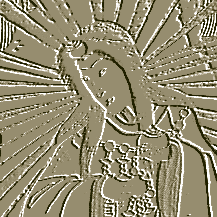
Caption: Amaterasu etched
The Sun, while principally seen as ruler of the
heavens, does not often figure in Creation stories. In this Japanese version,
however, we have Amaterasu, a sun goddess, representing the principal of light and
therefore life, on earth.
Kuat is the sun god for the Mamaiurans, an Amazon Indian tribe that lives in Brazil.
According to legend,
at the beginning of time there were so many birds in the sky that their wings prevented
the daylight from
being seen. It was always night and the people were forced to live in fear of attack from
wild animals.
Tired of the darkness, two Mamaiuran heroes, Iae and his brother Kuat, decided to force
the king of the
birds, Urubutsin, to give back some of the daylight. The two brothers hid themselves
inside a dead animal
And waited until the birds approached. As soon as Urubutsin landed, Kuat grabbed
Urubutsin's leg.
Unable to get away, Urubutsin was forced to make an agreement with the two brothers. The
birds would
share daylight with the Mamaiurans, and day would alternate with night. Kuat represented
the Sun and Iae
represented the Moon.
Culture Heroes
Along with the origin legends and tales of
the universe, the earth, and mankind, origin legends can tell of the finding of some great
boon to the people - the invention of writing (Thoth in Egypt, for example), the origin of
the Buffalo Hunt, or the beginnings of corn. Myths can also tell the
story of culture heroes that brought important ideas or technology. This account is from
A Collection of Ancient Legends of the Xavante People
Told by Airton Pini'awå and Coronel Wi'i
Recorded, written and compiled by Alec Harrison
Pictures by the author Airton Pini'awå
So now people were making fires all the time. This
story is a continuation of the Origin of Fire. Having discovered fire,
they are now finding new ways to benefit from it. But they still weren't cooking anything
with it.
Then a woman (who had been to the men's "wai'a" ceremony, and had received
special powers) encountered something. This Xavante woman was taken to a "wai'a"
ceremony traditionally off limits to women, where men acquire special powers.
She somehow was given the special powers normally available only to men. What did she
find? She discovered corn. In
this case, the multi-colored indigenous corn. So she discovered this corn that belonged to
the parakeet. Just as the jaguar
man possessed fire before the Xavante, the parakeet had possession of corn.
Then she went to where she could hear the parakeets making noise (squawking). She thought
to herself, "What are they making all that noise about? Then I'll just go see what it
is."
Then when she went to see what it was, she saw the corn. But first of all she and the
parakeet, the owner of the corn, met and got to know each other a little. They became
familiar with each other. Then this lady, she was a wonder doer; she had special powers.
Then she broke off some corn. She took it home. When she brought it home, she ate it in
secret with only her husband and
children. It all happened in secrecy. It was done in secret. At first she was being
selfish, knowing their wasn't enough to go
around.
Then every day she went and picked some corn. The corn was located near where the
parakeets lived. She kept picking the parakeet's corn that was kept at the palm trees
(where the parakeets lived).
Then when her house was full (of corn), she thought about it. She thought to herself,
"The baskets are all full (closed/covered because they are so full). The little
baskets are all stuffed." Then she made some corn bread. It hardened.
Then her husband made some wrist and ankle bands for his son, to get him painted up to go
around with (the corn). They
decided to reveal their secret to the others in the village, but in a dramatic fashion,
dressing up their son in ceremonial
style to draw attention. Then he painted up his son, who had the corn. He put body paint
on his son.
When he painted him, he said to him, "Here, take this and shoot it in front of all
the houses around the village. His instructions were to tie pieces of the hard corn bread
onto arrows and shoot them in front of the houses in the village. Shoot them around to all
the houses. Eat this also as you go." As he went from house to house shooting, he was
to stop and take a bite out of a piece as he went. After you are done taking a bite of the
corn, put it down on the ground (so you can shoot the bow and arrow well). Keep putting
the corn down for yourself. When someone calls to you wanting some, you will take it to
him. You will take some to him."
So then he started shooting the arrows (with pieces of corn on them). He shot the arrows
around in front of the houses. He ate it as he went. As he went he put the corn down on
the ground (to shoot).
Then the recently iniciated boys called for a meeting in the center of the village, to
sing to each other. How did they call out to each other? They called for each other like
this, "Kai, kai, kai, kai, kai!" This is a distinct call, used only by males in
that age group. There are many different kinds of calls used, depending on the age of the
caller, and the function of the calling.
This is how the young men called out to each other to have a meeting.
Then they saw him (and the corn). They just happened to have called a meeting at the time
the boy was dispersing the
corn, so naturally they spotted him as they came out of their houses.
Then they called out to the boy's uncle, "What is that over there that your nephew is
eating?"
Then he put (the corn) down in front of himself.
They said to each other, "Why don't you call him then, so we can see it!" They
are still talking to the boy's uncle, who
doesn't know what is going on either.
Then he called him, "My nephew, what is it you are eating? Bring it here then, so I
can see it." Then he took it (to him). He
obeyed (listened to) his uncle, in accordance with what his father had advised him to do.
He gave it to him.
"What is it?"
"It's corn bread."
"What is it really?"
"Corn."
"Where did it come from?" This is what his uncle asked him.
"It was mom that brought it."
Then they all saw it. Then all of the recent iniciates ate it together.
Then her brother got up from there. The boy's uncle (his mother's brother) got up to go
question the family. They all went
to his sister's house. They all went.
(Meanwhile) she had divided up the corn bread into piles for all of her brothers. She gave
some to every one of them.
Then people from all over made their way over to her. They followed each other over to
her.
Then they called for a meeting with everyone, with the old people. They called for each
other to meet in the center of the village. Until now only the youth were gathered in the
social hub of the village. Now that this was determined to be something of great
importance, the leaders (older generations) called everyone for a meeting.
Then they questioned the woman. They asked her, "Where is the corn, where is the
corn?" This is how the people questioned her thoroughly, a long time ago. It was a
thorough interrogation.
"They are singing and squawking from right over there, from right over there
nearby." This is what the woman told them about.
Then they said to her, "Ask them about it, ask them about it, to grant us (our
request)."
Then the woman went to ask (the parakeets) about it, to get permission for the people to
come pick the corn. Then the
parakeets gave up their corn (grain) immediately. They gave in right away. This is what
the parakeets said to each other, "Have the people pick the corn, have the people
pick the corn. Now we are going to eat only fruit, (even though) it hurts our mouths,
although it hurts our mouths." This is how the Xavante explain that despite the fact
that parakeets have hard beaks (like other parrots), they eat only soft fruit. This is how
the parakeets informed the woman.
Then the woman went back home. When she went, she told the people, "They gave the
command, they gave the command, for everyone to pick the corn, for everyone to pick the
corn." This is what the woman told them.
Then everybody got painted up for the occasion. This was quite an event, one to be
celebrated like a dance. All the old
people painted themselves up for it, and took deer skins with them. Everyone carried a
deer skin for the purpose of (collecting the corn). Then they didn't run on their way.
This is an impressive statement. Despite the fact that there was plentiful food to be had,
they managed to stay organized and orderly. Everybody lined up calmly.
Then the people headed out to get the corn. They went there after the corn.
Then the woman greeted the parakeets once again. Once again she inquired of the corn. But
their word was the same, and they consented right away. The woman was concerned that they
might have changed their mind in the interim.
Then the parakeets all flew away. They all left. They went off. They flew away from them.
Now the parakeet (habitually) eats fruit. Now parakeets hurt the inside of their mouths
with (acidy?) fruit. Now they are going to be hurting inside their mouths from eating
fruit.
Then everyone picked the corn. They all went over to the palm tree for the corn. The old
people piled up the corn mixed with droppings in their deer skins. The parakeets lived in
the palm trees above the corn, so there were droppings everywhere. But the old
people didn't care. They picked it up along with the corn, and didn't bother to separate
it. They made big piles of it. And so they picked the corn.
At this time a long time ago people had no (real) food. Before crops like corn, they were
strickly hunters and gatherers.
They didn't have food. So then corn became available. People did not have crops of their
own accord. The corn belonged to the parakeet. That is what the people now plant. That is
what people plant together all the time. That is what people eat now all the time.
So people are not hungry now. There is no hunger now. This is how a long time ago the
wonder-doer discovered the parakeets grain (corn). She discovered it. This is how the
woman's wonder working was; the woman that obtained the powers of the "wai'a",
and discovered this thing. This is the story of corn. And now this corn is what people eat
all the time.
http://www.sil.org/americas/brasil/anthro/englxvl2.htm
Copyright 1999 SIL International. All rights reserved.
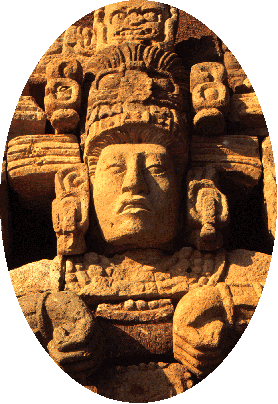
Caption: Aztec Warrior
Mything Links,
An Annotated & Illustrated Collection
of Worldwide Links to Mythologies,
Fairy Tales & Folklore,
Sacred Arts & Traditions
Kathleen Jenks, Ph.D.
Mythological Studies Department
Pacifica Graduate Institute
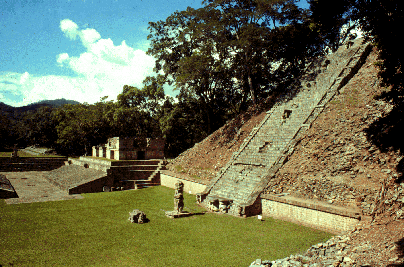
Caption: Ball court in Copan
This Harvard site (cross-listed
under Meso-America) is about a modern replica of an inaccessible
Mayan temple in Copan (Honduras) dating from the time of Copán's tenth ruler, Moon-Jaguar
(reigned
A.D. 553 to 578). A major deity in the original temple is the Mayan maize god:
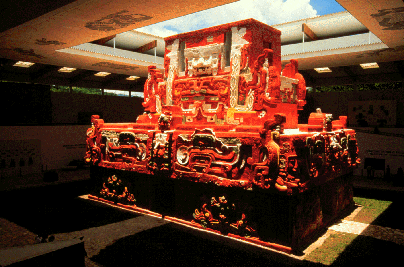
Caption: Creation Glyphs of Central America
As a whole, the temple represents a deified mountain - a place of creation, a source of
life-giving water (such as a cave, spring, stream, or waterfall), and birthplace of the
sacred
maize plant. The head of this mountain deity, which combines the attributes of both mother
and father, is depicted on the lower central part of the roof crest, with a cleft in its
forehead
from which maize sprouts. Draped over the sacred mountain images and framing the image
of a cave in the upper story are two-headed celestial dragons. Mythical creatures that
combine attributes of snakes and crocodiles, they are depicted like smoke emanating from
the skeletal-head censer in the center.
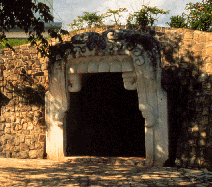
Caption: Mayan Entrance to Temple
Representations of the Sun God adorn the lower parts of the temple. The sun's daily
journey and the life cycle of maize were linked together in veneration of the process of
birth, life, death, and rebirth.
All of which leads us naturally to
the subject of our next lecture, Lecture VII - One Religion All Religions - where we will
look at the patterning of these tales.
end Lecture VI.
Return to Menu |







